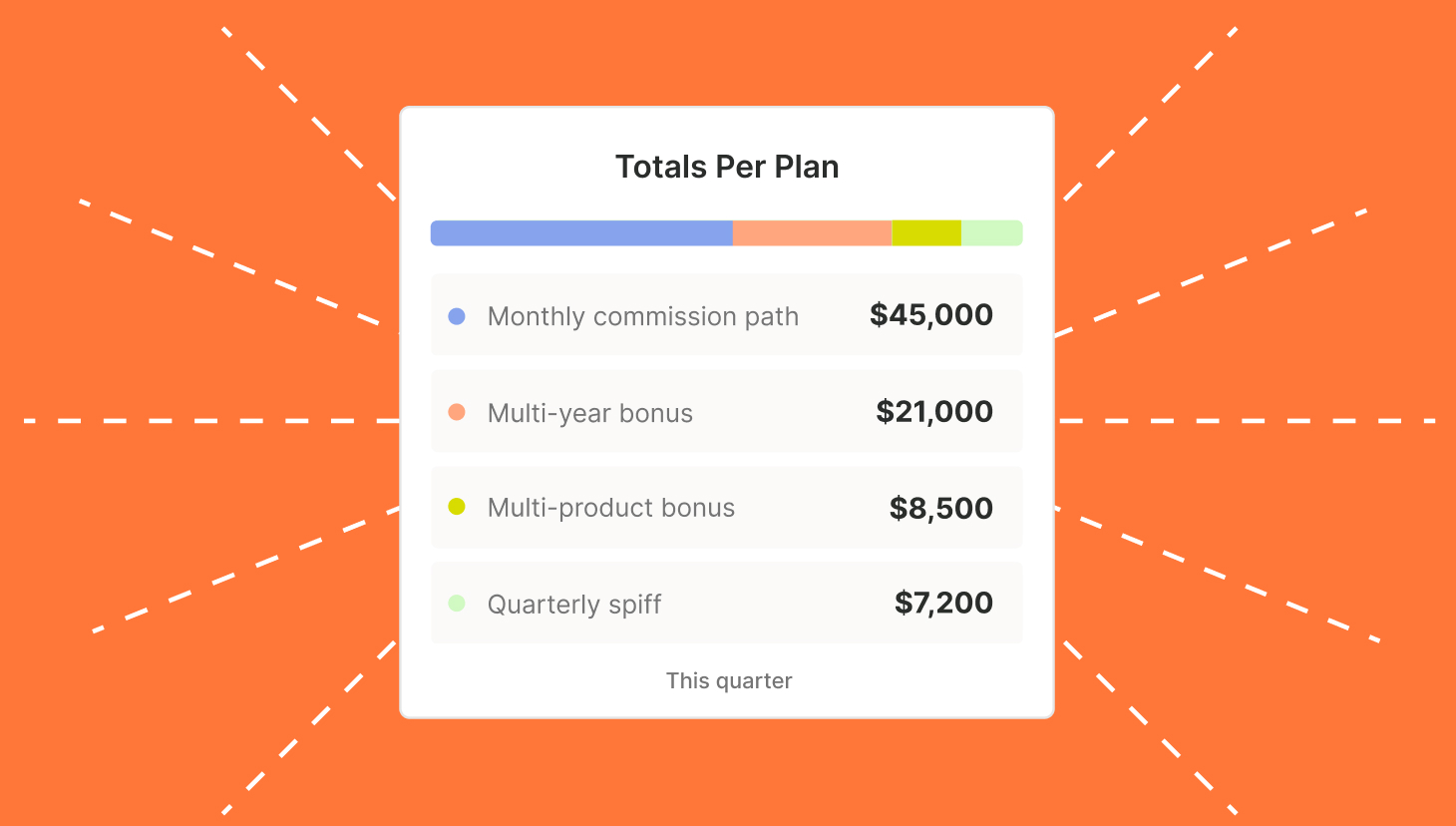Sales goals aren’t just practical; they’re also powerful motivators. When you’re in a leadership role, it’s your responsibility to find ways to light a fire under your sales team. It’s your job to help them, which helps you generate impressive numbers. You can’t move an inch in the sales industry without the word quota hitting you in the face, but quota isn’t everything. In fact, sometimes experimenting with unexpected and creative sales goals is far more thrilling — and effective.
Streamline commissions for your RevOps, Finance, and Sales teams
Design, track, and manage variable incentives with QuotaPath. Give your RevOps, finance, and sales teams transparency into sales compensation.
Talk to SalesWhat makes a good sales goal?
First things first. Before you can suggest your team aim at some outside-the-box targets, you need to make sure you’re setting everyone up for success.
“Hitting quota” is a good goal, but it’s also an obvious one. It fits the SMART framework — Specific, Measurable, Attainable, Relevant, Time-Based; however, it doesn’t always work. There are a lot of reasons reps fail to meet quota. One major contributor is the fact that such a broad, generic goal doesn’t speak to salespeople as individuals.
Try creating additional sales goals tailored to each specific person and what they’re looking to achieve. Also, ensure every goal is attached to a clearly defined outcome and timeframe.
The sales goal examples below tick all of those boxes. As a bonus, each offers suggestions on how to coach reps as they reframe their sales approach and embrace the opportunity for growth.
Sales goals
1. Improve demo-to-close ratio from X to Y over the next 90 days
When to use it: A rep is having a lot of conversations with prospects but not closing a lot of deals.
Ideally, the more a rep meets with prospects, the more deals they’ll close. When that doesn’t happen, it can feel defeating. Switching from a general sales quota to boosting their existing demo-to-close ratio builds on personal accomplishments and addresses a specific pain point — they’re not competing with anyone but themselves.
To help your sales team amp up their close rates, have them run through the demo process. Are they maximizing every opportunity? How are they tackling prospects’ objections? One way to help is to do a postmortem on lost deals. By identifying where things have gone wrong, you can offer suggestions on ways to improve. Try sharing alternative approaches that have proven successful in the past.
The 90-day timeframe allows for mini-goals or milestones. Continue revisiting the demo process to see how small tweaks affect interactions with prospects and keep the rep engaged and on track.
2. Generate $X in the new pipeline this month
When to use it: A rep is good at closing but doesn’t have the required deals in their pipeline to hit targets.
This is another situation when a close rate isn’t everything. Say a rep nails 100% of their demos but only schedules meetings with prospects twice a month — that scenario makes it difficult to hit quota or achieve any other meaningful target unless those closed deals are worth a ton. In some industries, two contracts every 30 days may be enough. In others, that’s miles from satisfactory.
Sales reps who need to liven up their pipeline should start by looking at their outbound sales strategies. How are they reaching out to prospects? What is their process for gathering and nurturing leads? Are they using email templates or personalizing each pitch?
There’s room to listen to a cold call and offer feedback. But it may be more productive to have the rep shadow a top demo seller. They’ll be able to see firsthand what a successful pitch looks like and how someone who’s hitting their numbers talks to prospects. Witnessing different ways a rep connects with strangers to establish rapport can be invaluable.
Sometimes increasing the number of deals in a rep’s pipeline is just a numbers game. If they’re not making cold calls, they need to start. If they’re making calls and sending emails sporadically, it’s time to step it up. Set short-term goals that suit the current campaign. This might include executing a certain number of calls and/or emails every day. That way there are plenty of opportunities to put new strategies to work. Help reps track what seems to be effective. Also, keep an eye on anything that doesn’t feel natural or fails to connect with prospects.
Create Compensation Plans with confidence
RevOps, sales leaders, and finance teams use our free tool to ensure reps’ on-target earnings and quotas line up with industry standards. Customize plans with accelerators, bonuses, and more, by adjusting 9 variables.
Build a Comp Plan3. Shorten sales cycle from X to Y days for the next 10 deals
When to use it: A sales rep closes many deals, but the process takes forever.
The exact steps in a sales cycle shift from industry to industry and even company to company, but everyone wants an efficient cycle. The more time you spend going from absolutely nothing to a closed deal represents a consistent usage of resources. While a rep is locked in negotiations with a potential client or busy fiddling with details in pursuit of a final agreement, they’re:
- Unable to turn their attention to other prospects
- Generating expenses without generating revenue
- At greater risk of the deal falling through
It’s important to note that super-short sales cycles aren’t always possible. For instance, imagine you’re in SaaS and pitching the CEO of a Fortune 500 company. It’ll be difficult to convince her to spend a few hundred thousand on a company-wide IT upgrade in a matter of days.
In a perfect world, long sales cycles exist in tandem with shorter cycles. That way, there are always deals being made and money coming in. The problem is when one rep’s sales cycle is significantly longer than his or her coworkers or the industry’s norm.
The key to improvement here is to shorten the sales cycle anywhere you can. Suggest your rep reconnect with prospects in one week instead of two or check back in a couple of days. Make the timeline a primary focus early on, and encourage reps to ask more questions about a prospect’s timeline. They may need to practice pushing back — within reason, of course — if the customer suggests touching base too far into the future.
4. Increase average contract value by $X by the end of this fiscal year
When to use it: A rep is closing a lot of deals, but they’re small.
Every contract counts, but if we’re honest, some count more than others. There are no participation prizes in sales — revenue matters. Reps have to sell and sell big. A salesperson who’s closing many deals every year but has a low average contract value might have one of the easiest paths forward. After all, they’ve already proven they can connect with prospects and convert them into customers. Now all that’s left is to work on the skills necessary to convince those customers to spend more.
This goal is all about the upsell. Train your rep on additional products and how they complement each other, so it’s easier to explain the benefits of buying more. Negotiation training can be helpful, too:
- Teach what not to do, such as making assumptions or rushing into an agreement
- Outline the perks of coming to the table prepared and what proper preparation looks like
- Discuss the importance of impartiality and the dangers of taking negotiations personally
- Talk about the power of empathy and how using emotion to balance out rational arguments can be exponentially more effective
- Encourage reps to look at negotiations as a way to build relationships by listening, taking opinions and preferences on board, and forging connections
Another way to increase the average contract value is to go after bigger accounts. Larger companies typically have larger budgets and a greater need for products and services. Check with reps who may feel intimidated; role-playing exercises and mentorship can go a long way to instilling some much-needed confidence.
As for the timeframe of this goal, it depends on how long your sales cycle is. Are you at the start of a new fiscal year and your reps close a handful of deals per year? Then you can make it a ‘this fiscal year’ goal. A full sales year might be too long if you’re closing 50+ deals in a year. If you have this as a goal, you just might have the best sales year yet.
5. Have X% of this quarter’s revenue come from Y industry
When to use it: A rep is being overly reliant on one specific industry. This is especially true if that industry isn’t great for you or the powers that be.
Most people don’t go out of their comfort zone unless they have to. Reps who know a certain industry like the back of their hand may be reluctant to test the waters elsewhere. They know the clients, the lingo, and how businesses in that industry operate. It’s easier to sell because they’ve addressed common pain points multiple times and can speak to prospects from a place of experience. The issue is that you can only go back to the same well so many times before the water runs out.
Diversification equals opportunity. Empower your rep to take on a new-to-them industry or expand their work in an under-serviced niche. They may need sales training to understand that new industry. On the other hand, it could just be a matter of starting them out with a set of high-quality accounts.
6. Sales team goal of $X this quarter
When to use it: When you have one or two top sellers on the team and the rest of the team is struggling.
Okay, I know I saw these sales goals aren’t “hit quota” but this is slightly different. As a sales team leader, your success hinges on the success of every team member. Encouraging your team to focus on team sales goals can cause an overall lift on the team’s attainment.
What you may see with a sales team goal is more collaboration and teamwork. If one team member is struggling, another team member could lift them up or provide assistance on a deal. That doesn’t mean the team leader can rely on this, though. Especially if you have a remote sales team (seems like nearly every sales team is a remote sales team!) this could be a good goal.
If you roll this out and have your team meet this goal, a good incentive is an extra bonus for everyone on the team. Give your team a little extra cash or a day off. Or maybe you give your team quota relief for a tough month. This might motivate your team to hit a stretch goal!
Encouraging your reps, no matter their sales goals
You may be juggling 10 reps with just as many divergent sales goals, but some things remain the same. As you work on tracking progress and monitoring KPIs, don’t neglect the human element. The skills you’re teaching work for the campaign’s lifetime, but they also work for the rep’s entire lifetime. Focusing on growth first and money second makes sense. Take care of the first, and the second will follow.
Customer acquisition can be a tricky game. Converting prospects into profitable B2B clients is even trickier. But your job as a manager is to give your people feedback to help them leapfrog to the next level. Do that, and you’ll foster team loyalty, meet your objectives, and perhaps even exceed your forecast.
Setting sales goals that speak to each individual takes practice, but the results are worth the work. No matter what goals you decide to give your reps, it’s imperative to keep an eye on their progress. Use QuotaPath to track your reps’ growth, so everyone knows where they stand every step of the way.



